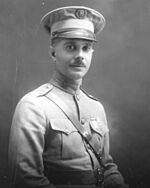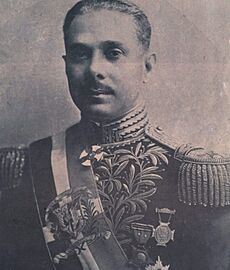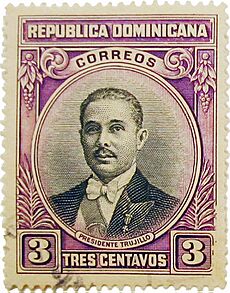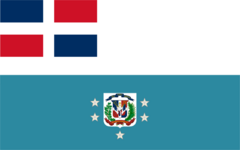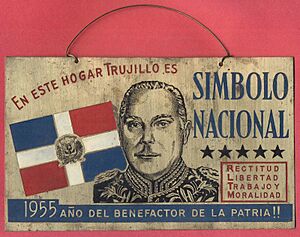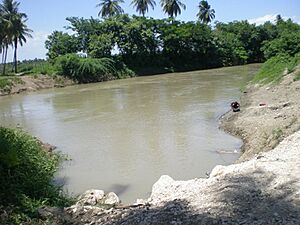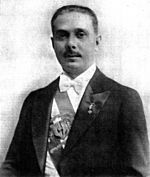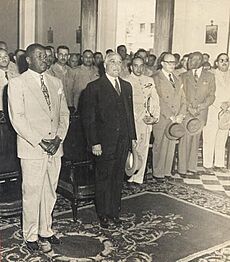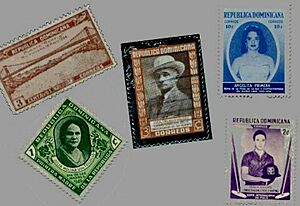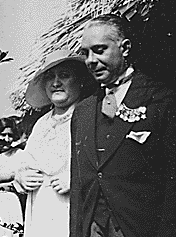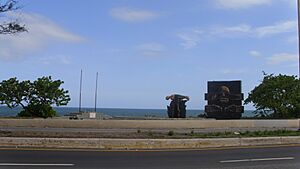Rafael Trujillo facts for kids
Quick facts for kids
Generalissimo
Rafael Trujillo
|
|
|---|---|
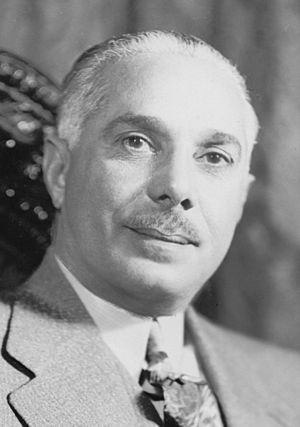
Trujillo in 1940
|
|
| Generalissimo of the Dominican Republic | |
| In office 1934 – 30 May 1961 |
|
| Preceded by | Position established |
| Succeeded by | Ramfis Trujillo |
| President of the Dominican Republic | |
| In office 18 May 1942 – 16 August 1952 |
|
| Vice President | None |
| Preceded by | Manuel de Jesús Troncoso de la Concha |
| Succeeded by | Héctor Trujillo |
| In office 16 August 1930 – 16 August 1938 |
|
| Vice President | Rafael Estrella Ureña (1930–1932) Vacant (1932–1934) Jacinto Peynado (1934–1938) |
| Preceded by | Rafael Estrella Ureña (Acting) |
| Succeeded by | Jacinto Peynado |
| Personal details | |
| Born |
Rafael Leónidas Trujillo y Molina
24 October 1891 San Cristóbal, Dominican Republic |
| Died | 30 May 1961 (aged 69) Ciudad Trujillo, Dominican Republic |
| Cause of death | Assassination |
| Resting place | Mingorrubio Cemetery, Madrid, Spain |
| Political party | Dominican Party |
| Spouses |
Aminta Ledesma y Pérez
(m. 1913; div. 1925)Bienvenida Ricardo y Martínez
(m. 1927; div. 1935)María de los Ángeles Martínez y Alba
(m. 1937) |
| Relations |
|
| Children | 8, including Ramfis and Angelita |
| Profession |
|
| Signature |  |
| Military service | |
| Allegiance | |
| Branch/service |
|
| Years of service | 1916–1961 |
| Rank | (1934–1961) |
Rafael Leónidas Trujillo Molina (born October 24, 1891 – died May 30, 1961) was a powerful military leader and dictator. He ruled the Dominican Republic for 31 years, from August 1930 until he was assassinated in May 1961. People called him El Jefe, which means "The Chief."
Trujillo was president from 1930 to 1938 and again from 1942 to 1952. For the rest of his rule, he was the real power behind other presidents. This time is known as the Trujillo Era. It was one of the longest rules by a non-royal leader. His government was very strict and violent. His security forces, like the SIM, were responsible for many deaths. This included a terrible event in 1937 called the Parsley massacre, where thousands of Haitians were killed.
Trujillo's government also used violence outside the country. They tried to kill the Venezuelan President Rómulo Betancourt in 1960. They also kidnapped and killed people in other countries. These actions made the Dominican Republic's relationship with other nations very bad. The OAS put sanctions on the country. Many Dominicans, even in the military, started to turn against Trujillo.
On May 30, 1961, a group of people led by General Antonio Imbert Barrera killed Trujillo. After his death, Trujillo's son, Ramfis, took control for a short time. He had many of the people who plotted against his father killed. By November 1961, the Trujillo family was forced to leave the country. This led to a Dominican Civil War and later a more open government.
Trujillo's time in power was during a period when many dictators ruled in the Caribbean. He is still a debated figure in the Dominican Republic. Some people say he brought stability and economic growth. Others remember his cruel rule, racism, and how his family took advantage of the country's resources.
Contents
- Rafael Trujillo's Early Life
- How Trujillo Gained Power
- Trujillo's Time in Government
- The Cult of Personality Around Trujillo
- How Trujillo Oppressed People
- Immigration Policies
- Trujillo's Environmental Actions
- Foreign Relations During Trujillo's Rule
- Trujillo's Personal Life
- Trujillo's Assassination
- See also
Rafael Trujillo's Early Life
Rafael Leónidas Trujillo y Molina was born on October 24, 1891. His family lived in San Cristóbal, Dominican Republic. They were a lower-middle-class family.
His father, José Trujillo Valdez, had Spanish roots. His mother, Altagracia Julia Molina Chevalier, had Haitian and French ancestors. Trujillo was the third of eleven children.
When he was six, Trujillo started school. He was very interested in how he looked. He even put bottle caps on his clothes to look like military medals. At 16, he worked as a telegraph operator for three years. Later, he got involved in small crimes like stealing cattle. He even spent time in prison. After that, he formed a group of robbers called The 42.
How Trujillo Gained Power
In 1916, the United States occupied the Dominican Republic. This happened after many revolutions in the country. Trujillo was 25 years old and worked on a sugar cane farm. The US forces created a new army called the National Guard. Trujillo joined it in 1918. He quickly moved up in rank. He trained with US Marines.
By 1924, President Horacio Vásquez made Trujillo the head of the National Police. Trujillo changed the police into an army under his control. In 1930, a rebellion started against President Vásquez. Trujillo secretly made a deal with the rebel leader, Rafael Estrella Ureña. Trujillo would let Estrella take power. In return, Estrella would let Trujillo run for president.
When the rebels marched to the capital, Vásquez told Trujillo to stop them. But Trujillo kept his soldiers in their barracks. This allowed the rebels to take the capital easily. Trujillo then became the presidential candidate. Other candidates were harassed by the army. They eventually dropped out of the election. Trujillo won with almost all the votes. Many people believe the election was unfair. On August 16, 1930, Trujillo became president and took full control. He kept this power for the next three decades.
Trujillo's Time in Government
Just weeks after Trujillo became president, a huge hurricane hit Santo Domingo. It killed 2,000 people. Trujillo declared martial law to help rebuild the city. He then renamed the capital city to Ciudad Trujillo ("Trujillo City") in his own honor. He also had streets and monuments named after himself.
On August 16, 1931, Trujillo made the Dominican Party the only legal political party. All government workers had to give 10% of their salary to the government. Citizens were pressured to join the party. Members had to carry a special card called the "Palmita." If you didn't have one, you could be arrested. People who opposed Trujillo often disappeared or were killed.
In 1934, Trujillo promoted himself to generalissimo of the army. He was re-elected president without anyone running against him. He also held "civic reviews" where large crowds would shout their loyalty to him. This helped him gain more support.
The Cult of Personality Around Trujillo
In 1936, the Dominican Congress voted to change the capital's name from Santo Domingo to Ciudad Trujillo. The province of San Cristóbal was renamed "Trujillo." Even the highest mountain, Pico Duarte, became Pico Trujillo. Many statues of "El Jefe" were put up everywhere. Bridges and buildings were also named after him.
Newspapers always praised Trujillo on their front pages. License plates had slogans like "¡Viva Trujillo!" (Long Live Trujillo!). An electric sign in Ciudad Trujillo read "Dios y Trujillo" (God and Trujillo). Later, churches had to display "Dios en el cielo, Trujillo en la tierra" (God in Heaven, Trujillo on Earth). Eventually, this was even changed to "Trujillo on Earth, God in Heaven." Some people even suggested him for the Nobel Peace Prize, but he didn't get it.
In 1938, Trujillo said he wouldn't run for president again. He claimed he was following the US example of two terms. But this was mainly because of international anger after the Parsley Massacre. His chosen successor, Jacinto Peynado, became president. But everyone knew Trujillo still held all the power. Peynado died in 1940. In 1942, Trujillo ran for president again and won without opposition. He served two more terms. In 1952, he gave the presidency to his brother, Héctor. Even then, Rafael Trujillo still organized big celebrations for his 25 years in power.
How Trujillo Oppressed People
From the start, Trujillo's rule was marked by harsh treatment of anyone who seemed to oppose him. His gang, "The 42," drove around in a "car of death." Trujillo also had a list of enemies around the world. He even allowed an opposition party to form once. This was so he could find out who opposed him and then arrest or kill them.
Later, the SIM (Military Intelligence Service) handled arrests and killings. This group was very effective. Some cases became famous around the world. These included the disappearance of Jesús de Galíndez and the murder of the Mirabal sisters. These events made the US government less supportive of Trujillo. After Trujillo tried to assassinate the Venezuelan President Rómulo Betancourt, the OAS and the US stopped giving him access to sugar profits.
In 1962, after the Trujillo family left the country, an official report came out. It said that in the previous five years, Trujillo's regime was responsible for 5,700 deaths. Many victims' families never got their loved ones' bodies back. It is believed many were thrown to sharks or burned.
Immigration Policies
Trujillo was known for his "open-door policy" for some groups. He welcomed Jewish refugees from Europe. He also allowed Japanese people to migrate in the 1930s. And he accepted exiles from Spain after their civil war. At a meeting in 1938, the Dominican Republic was the only country willing to take many Jewish refugees. Trujillo even gave land for them to settle.
These refugees helped the Dominican Republic's economy. They also added more white people to the country. However, Trujillo's government preferred white refugees. At the same time, Dominican troops expelled illegal immigrants. This led to the 1937 Parsley Massacre of Haitian migrants.
Trujillo's Environmental Actions
Trujillo's government greatly expanded a nature reserve around the Yaque del Sur River. In 1934, he banned the "slash-and-burn" method of clearing land. He also created a forest warden agency to protect parks. Cutting down pine trees without his permission was also forbidden.
In the 1950s, Trujillo's government studied how to build dams for electricity. They found that only forested rivers could support these dams. So, Trujillo banned logging in areas around these rivers. After he was killed in 1961, logging started again. Forests were burned for farming, and companies cut down trees in parks. In 1967, President Joaquín Balaguer had to use military force to stop illegal logging.
Trujillo also encouraged foreign companies to invest in the Dominican Republic. He gave rights to oil in the Azua Basin to an American oilman.
Foreign Relations During Trujillo's Rule
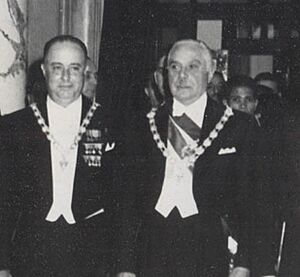
Trujillo generally tried to have good relations with the United States. During World War II, he supported the Allies. He declared war on Germany, Italy, and Japan in 1941. This made the Dominican Republic a founding member of the United Nations.
While he wanted strong ties with the US, his actions often caused problems with other Latin American countries. He was friendly with leaders like Francisco Franco of Spain and Somoza of Nicaragua. Towards the end of his rule, his relationship with the United States worsened.
Ending US Control Over Customs
Trujillo wanted to take control of the Dominican Republic's money. Since 1907, the United States had collected customs taxes in the country. This was a situation Trujillo wanted to change.
Negotiations began in 1936 and lasted four years. On September 24, 1940, Trujillo and the US Secretary of State signed the Hull–Trujillo Treaty. This agreement gave the Dominican Republic control over its customs money. In return, the country promised to put government money in a special bank account to pay back foreign debts.
This was a big success for Trujillo. He used it to create a huge propaganda campaign. He was called the "Restorer of the Republic's financial independence."
Relations with Haiti
Haiti had previously occupied the Dominican Republic for 22 years. When Trujillo came to power, the border area between the two countries was becoming more "Haitianized." The border was not clearly marked. Trujillo met with Haitian President Sténio Vincent in 1933 and 1935 to fix the border. They signed an agreement in 1936.
However, Trujillo also secretly worked against the Haitian government. When more border problems happened, Trujillo ordered the Parsley Massacre.
The Parsley Massacre
Known as La Masacre del Perejil in Spanish, this terrible event began in 1937. Trujillo claimed that Haiti was hiding his enemies. He ordered an attack along the border. Thousands of Haitians were killed as they tried to escape. The number of dead is estimated to be between 12,000 and 30,000.
Haiti's government eventually asked for an international investigation. Under pressure from the US, Trujillo agreed to pay $750,000 in reparations in 1938. By the next year, this amount was reduced to $525,000. Only a small amount of this money reached the victims' families due to corruption in Haiti.
Relations with Cuba
In 1947, Dominicans who opposed Trujillo gathered in Cuba. With Cuba's support, they planned to invade the Dominican Republic and overthrow Trujillo. But international pressure, especially from the US, stopped the invasion.
Later, when Fulgencio Batista was in power in Cuba, Trujillo first supported Batista's opponents. However, weapons Trujillo sent to these opponents ended up with Fidel Castro's rebels. Dominican-made weapons became common for Castro's fighters.
After 1956, Trujillo saw that Castro was gaining power. He then started to support Batista with money, planes, and men. Trujillo was surprised when Batista was overthrown and came to him as a fugitive. Trujillo kept Batista as a "virtual prisoner" until Batista paid a large sum of money to leave.
Castro threatened to overthrow Trujillo. Trujillo responded by increasing his country's defense budget. He even formed a foreign legion to defend Haiti, thinking Castro might invade there first. In 1959, Cuban planes and yachts brought invaders to the Dominican Republic, but the Dominican Army defeated them.
Attempted Assassination of Betancourt
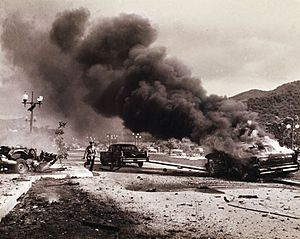
By the late 1950s, more and more people were against Trujillo's rule. Younger Dominicans, who hadn't known the poverty before Trujillo, wanted democracy. Trujillo's government responded with even more repression. The SIM secret police, led by Johnny Abbes, continued their widespread operations. Other countries started to avoid the Dominican Republic.
Trujillo began to interfere in other countries' affairs. He strongly disliked Venezuela's president, Rómulo Betancourt, who was a strong critic of Trujillo. Trujillo supported many plots by Venezuelan exiles to overthrow Betancourt. This interference led Venezuela to complain about Trujillo to the Organization of American States (OAS). This made Trujillo furious. He ordered his agents to plant a bomb in Betancourt's car. The assassination attempt happened on June 24, 1960. Betancourt was injured but survived.
The attack on Betancourt angered the world. OAS members voted to cut off diplomatic relations and impose economic sanctions on the Dominican Republic. The brutal murder of the three Mirabal sisters on November 25, 1960, further increased anger against Trujillo. The sisters were famous opponents of his rule. Trujillo had become an embarrassment to the United States. Relations between them became very tense after the Betancourt incident.
Trujillo's Personal Life
Trujillo's main goal was power. He also wanted a lot of money, which he saw as a way to keep his power. He woke up early, exercised, read reports, and worked hard. He was very organized and kept secrets. He didn't have true friends, only people he worked with. His actions towards others were often unpredictable.
Trujillo and his family became very rich. He bought huge amounts of land for cattle. He also took control of industries like meat, milk, salt, sugar, tobacco, lumber, and the lottery. His family members also got important jobs in the government and army. One of his sons was made a colonel at only four years old. Two of his brothers, Héctor and José Arismendy, also held positions in his government. José Arismendy Trujillo helped create the main radio station, La Voz Dominicana, and later a television station.
By 1937, Trujillo's yearly income was about $1.5 million. When he died, the government took over 111 companies that he owned. He loved fancy clothes and uniforms. He had almost two thousand uniforms and over ten thousand neckties. He also liked to wear perfume and hear gossip.
Trujillo was married three times and had other relationships. He had children with his wives and other women. His children with María Martínez were Rafael Leónidas Ramfis, María de los Ángeles del Sagrado Corazón de Jesús (Angelita), and Leónidas Rhadamés. Ramfis and Rhadamés were named after characters in an opera.
Even though Trujillo wasn't very interested in baseball, he invited many black American players to the Dominican Republic. They were paid well and played on teams that were not segregated. The famous player Satchel Paige played for a team organized by Trujillo.
Trujillo was energetic and healthy. He had some health issues later in life, but he was generally fit. He owned many homes. His favorite was Casa Caobas near San Cristóbal. He also had a penthouse in the capital.
While Trujillo was officially a Roman Catholic, his religious practices were mostly for public show. He also believed in local folk religion. People called him "El Jefe" ("The Chief") or "El Benefactor" ("The Benefactor"). But privately, some called him Chapitas ("Bottlecaps") because he wore so many medals. Dominican children would even make toy medals from bottle caps to imitate him.
Trujillo's Assassination
On May 30, 1961, Trujillo was killed. His blue 1957 Chevrolet Bel Air was ambushed on a road outside the capital. A group of men, including General Juan Tomás Díaz, Pedro Livio Cedeño, Antonio de la Maza, Amado García Guerrero, and General Antonio Imbert Barrera, planned the attack.
Aftermath of the Assassination
The people who planned the assassination failed to take control of the country. One of the conspirators, General José René Román Fernandez, did not act as planned. Trujillo's son, Ramfis Trujillo, and the SIM secret police quickly hunted down the plotters. Many suspects were arrested and tortured. On November 18, six of the conspirators were executed. Antonio Imbert Barrera was the only one of the seven main assassins who survived.
US President John F. Kennedy learned of Trujillo's death during a meeting. Trujillo's funeral was like that of a statesman. His body was first buried in his hometown of San Cristóbal. The Trujillo family tried to keep control of the country, but they failed. A military uprising and the threat of US intervention ended the Trujillo regime. Ramfis tried to leave the country with his father's body but was stopped. Later, he was allowed to take his father's body to Paris. Six years later, the remains were moved to Spain.
United States' Role in the Killing
The role of the United States' Central Intelligence Agency (CIA) in Trujillo's killing has been discussed a lot. One of the assassins, Imbert, said they acted alone. However, Trujillo was killed with weapons supplied by the CIA. A 1975 report said the CIA had "no active part" but a "faint connection" to the plotters.
However, US involvement seems to be deeper. In the 1950s, the CIA gave money to José Figueres Ferrer to publish a political journal. Funds also went to other anti-Trujillo groups. As the US wanted to unite Latin America against Fidel Castro in Cuba, Trujillo became less important to them. People who opposed Trujillo believed that killing him was the only way to remove him.
An internal CIA document from 1973 showed "quite extensive Agency involvement with the plotters." The CIA described its role in changing the Dominican Republic's government as a "success." They said it helped the country move from a dictatorship to a democracy.
Juan Bosch, who had received CIA funding earlier, was elected president of the Dominican Republic in 1962. However, he was removed from power in 1963.
Even after Trujillo's death, strange events continued. In 1961, Trujillo's godson, Luis Melchior Vidal Jr., was found dead in Mexico. Vidal was involved in arms dealing for the CIA. In 1962, Joel David Kaplan was convicted of killing Vidal. Kaplan later escaped from a Mexican prison using a helicopter. This escape became the basis for the Charles Bronson film Breakout.
See also
 In Spanish: Rafael Leónidas Trujillo para niños
In Spanish: Rafael Leónidas Trujillo para niños


